Situational panic attacks are intense episodes of fear and anxiety that occur in specific environments, often triggered by identifiable stressors. These attacks can arise suddenly, leading to overwhelming emotional and physical responses that disrupt daily life. Understanding the nature of these attacks and their triggers is crucial for effective management and coping strategies.
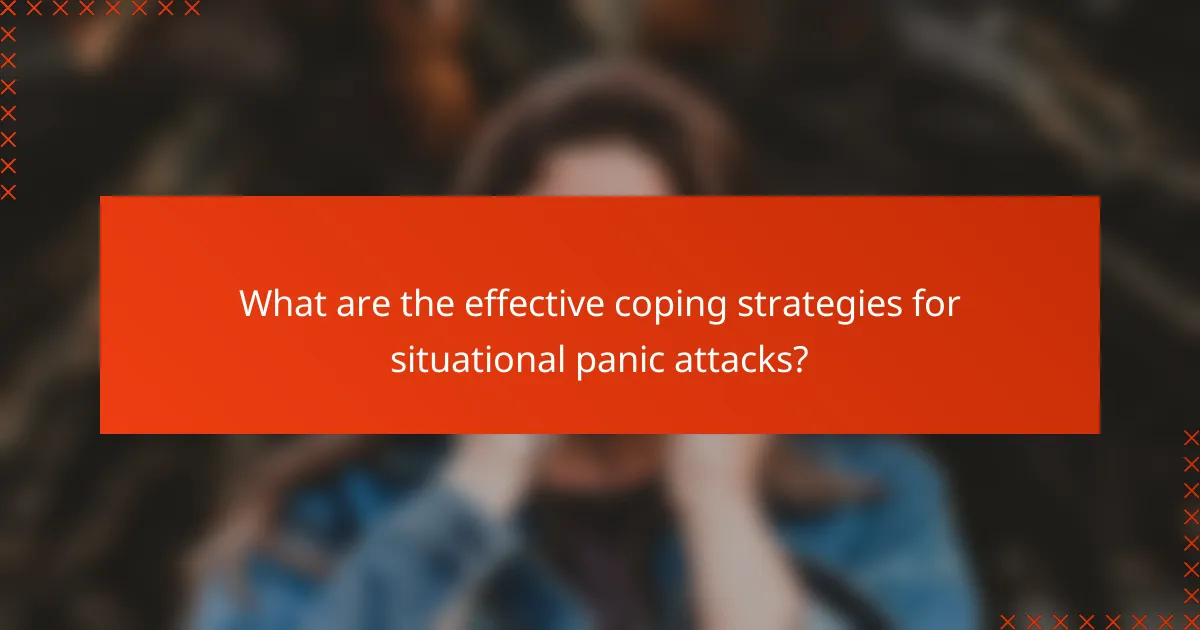
What are the effective coping strategies for situational panic attacks?
Effective coping strategies for situational panic attacks include various techniques that help manage symptoms and reduce anxiety. These strategies can be practiced in real-time during an episode or integrated into daily routines for long-term relief.
Breathing exercises
Breathing exercises are a fundamental technique for managing panic attacks. They help regulate your body’s response to stress by slowing down your heart rate and promoting relaxation. A common method is the 4-7-8 technique: inhale for 4 seconds, hold for 7 seconds, and exhale for 8 seconds.
Practicing these exercises regularly can enhance their effectiveness during an actual panic attack. Aim to spend a few minutes each day focusing on your breath, which can help create a sense of calm when faced with anxiety-inducing situations.
Grounding techniques
Grounding techniques help anchor you in the present moment, reducing feelings of panic. One effective method is the 5-4-3-2-1 technique, where you identify five things you can see, four things you can touch, three things you can hear, two things you can smell, and one thing you can taste.
These techniques can be particularly useful in situations where panic attacks are triggered, such as crowded places or during public speaking. Regular practice can make it easier to access these grounding methods when needed.
Cognitive Behavioral Therapy (CBT)
Cognitive Behavioral Therapy (CBT) is a structured, time-limited approach that helps individuals identify and change negative thought patterns associated with panic attacks. Through CBT, you can learn to challenge irrational fears and develop healthier coping mechanisms.
Working with a trained therapist can provide personalized strategies and support. Many find that CBT sessions, often lasting several weeks to months, significantly reduce the frequency and intensity of panic attacks.
Medication options
Medication can be an effective option for managing situational panic attacks, especially for those with severe symptoms. Common types include selective serotonin reuptake inhibitors (SSRIs) and benzodiazepines, which can help alleviate anxiety and panic symptoms.
Consulting with a healthcare provider is essential to determine the best medication for your situation, as they can discuss potential side effects and the appropriate dosage. Regular follow-ups can help monitor effectiveness and make necessary adjustments.
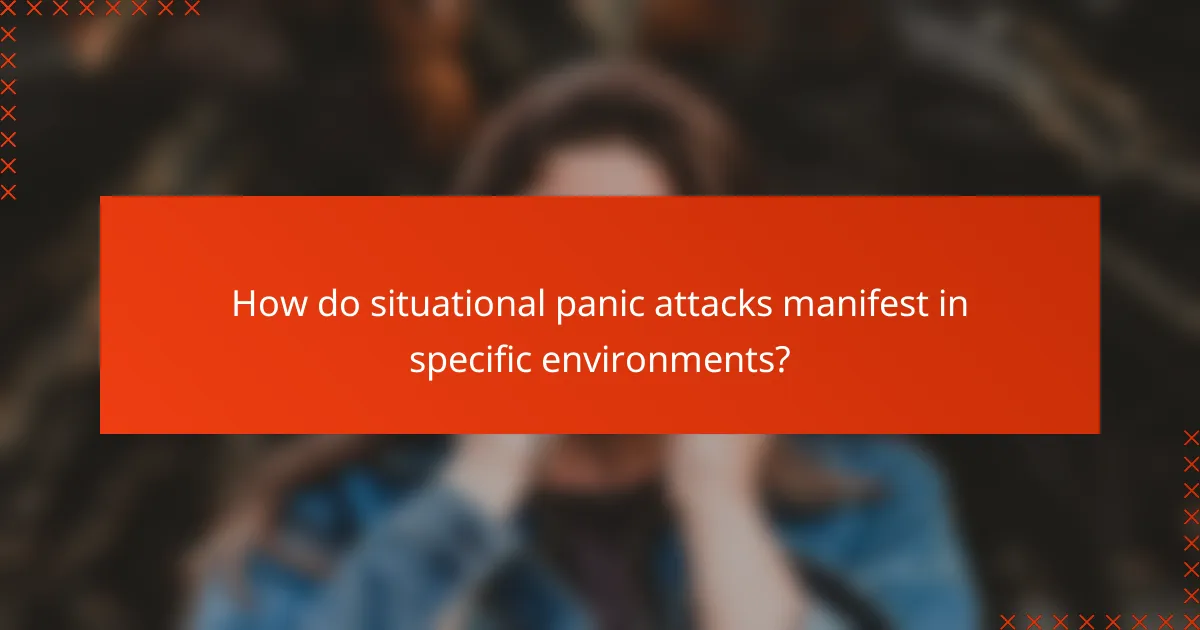
How do situational panic attacks manifest in specific environments?
Situational panic attacks occur in specific environments, often triggered by particular stressors or stimuli. These attacks can lead to intense feelings of fear, anxiety, and physical symptoms, making it essential to understand how they manifest in different settings.
Public speaking scenarios
Public speaking is a common trigger for situational panic attacks, as the fear of judgment or failure can provoke anxiety. Individuals may experience symptoms like rapid heartbeat, sweating, or trembling when faced with an audience. Preparation and practice can help reduce these feelings, but it’s crucial to recognize personal limits and seek support if needed.
To manage anxiety in public speaking, consider using techniques such as deep breathing or visualization. Practicing in front of a small, supportive group can also build confidence and reduce the likelihood of a panic attack during larger presentations.
Crowded places
Crowded places, such as shopping malls or public transport, can trigger panic attacks due to feelings of being overwhelmed or trapped. The close proximity of others may heighten anxiety, leading to symptoms like dizziness or shortness of breath. It’s important to identify personal triggers within these environments to better manage responses.
To cope with anxiety in crowded settings, try to have an exit strategy in mind. Carrying a calming item, such as a stress ball or fidget toy, can also provide comfort. If possible, choose less busy times to visit these places to minimize stress.
Driving in heavy traffic
Driving in heavy traffic can lead to situational panic attacks, especially for those who feel a lack of control or are anxious about potential accidents. Symptoms may include rapid breathing, sweating, or a racing heart. Understanding these triggers can help drivers prepare and respond more effectively.
To alleviate anxiety while driving, practice relaxation techniques before getting behind the wheel. Listening to calming music or using guided meditation apps can help maintain a sense of calm. If traffic becomes overwhelming, consider pulling over safely to regroup before continuing your journey.
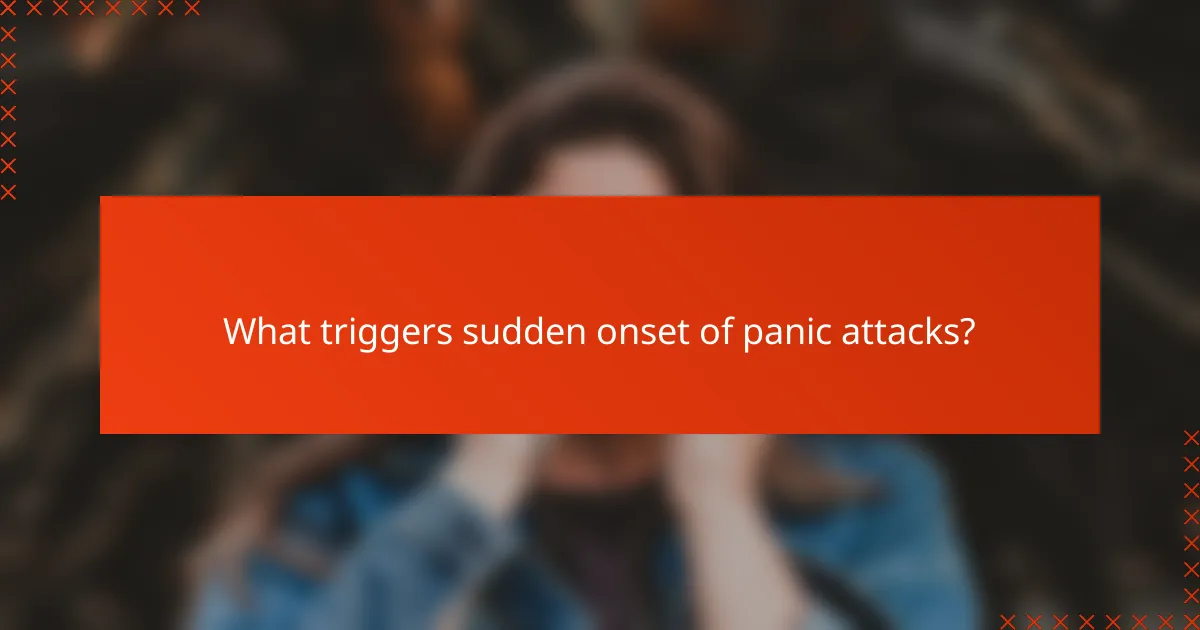
What triggers sudden onset of panic attacks?
Sudden onset of panic attacks can be triggered by various factors, often linked to stress or anxiety. Recognizing these triggers is essential for managing and preventing future episodes.
Stressful life events
Stressful life events, such as the loss of a loved one, job changes, or relationship issues, can significantly increase the likelihood of experiencing panic attacks. These situations often create overwhelming emotional responses that can lead to sudden panic.
It’s crucial to identify and address these stressors. Consider talking to a mental health professional who can help you develop coping strategies tailored to your specific circumstances.
Substance use
Substance use, including alcohol, caffeine, and recreational drugs, can act as triggers for panic attacks. These substances can alter brain chemistry and exacerbate feelings of anxiety, leading to unexpected panic episodes.
Limiting or avoiding these substances may help reduce the frequency of panic attacks. If you find it challenging to cut back, seeking support from a healthcare provider can be beneficial.
Health concerns
Health concerns, particularly those related to chronic illnesses or sudden medical issues, can provoke panic attacks. The fear of serious health problems can create a cycle of anxiety that triggers panic symptoms.
Staying informed about your health and maintaining regular check-ups can help alleviate some of these fears. If health-related anxiety becomes overwhelming, consider consulting a mental health professional for support and guidance.
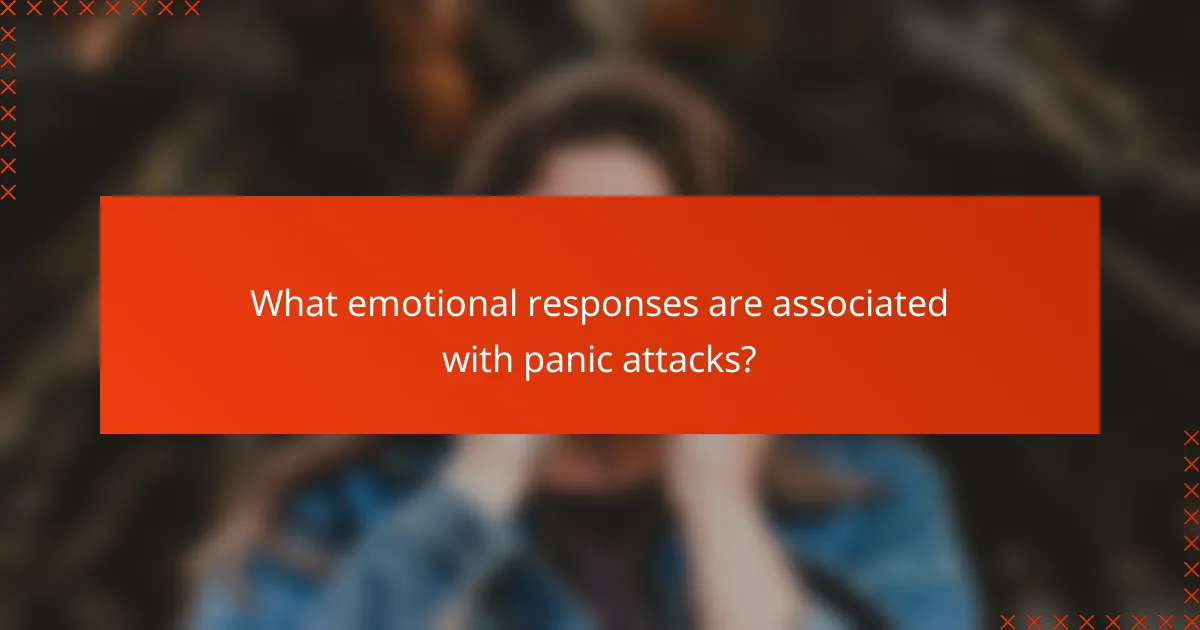
What emotional responses are associated with panic attacks?
Panic attacks trigger a range of intense emotional responses, primarily characterized by overwhelming fear and anxiety. These reactions can manifest suddenly and may lead to feelings of losing control, unreality, and heightened anxiety levels.
Fear of losing control
During a panic attack, individuals often experience a profound fear of losing control over their thoughts and actions. This fear can stem from the sudden onset of symptoms, such as rapid heartbeat or shortness of breath, which may feel overwhelming and disorienting.
People may worry that they will embarrass themselves or act irrationally in public settings. This fear can lead to avoidance behaviors, where individuals steer clear of situations that they associate with previous panic attacks.
Feelings of unreality
Many individuals report feelings of unreality or detachment from their surroundings during a panic attack. This sensation, known as derealization, can make the environment feel strange or dreamlike, intensifying the sense of panic.
These feelings can be alarming and may contribute to the overall distress of the experience. It’s important to recognize that these sensations are temporary and often subside once the panic attack passes.
Intense anxiety
Intense anxiety is a hallmark of panic attacks, often manifesting as a sudden surge of fear that can be difficult to manage. This anxiety can be accompanied by physical symptoms such as sweating, trembling, or a racing heart, which can further exacerbate the emotional response.
Understanding that these feelings are common during panic attacks can help individuals cope better. Techniques such as deep breathing, grounding exercises, and mindfulness can be effective in reducing anxiety levels during an episode.
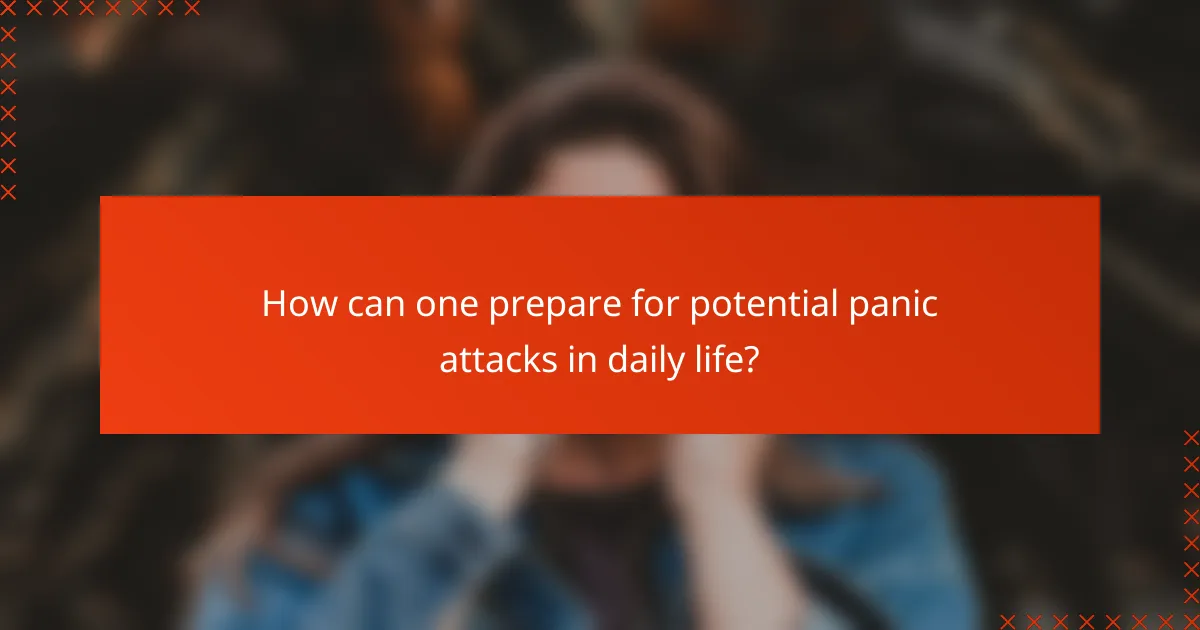
How can one prepare for potential panic attacks in daily life?
Preparing for potential panic attacks involves recognizing your triggers, building a reliable support network, and incorporating mindfulness practices into your routine. These strategies can help you manage anxiety and reduce the likelihood of experiencing panic attacks in various environments.
Identifying triggers
Identifying triggers is crucial for managing panic attacks effectively. Common triggers may include crowded places, specific social situations, or even certain thoughts and memories. Keeping a journal to note when panic attacks occur can help pinpoint these triggers.
Once you identify your triggers, you can develop strategies to cope with them. For instance, if crowded places induce anxiety, consider visiting during less busy hours or practicing deep breathing exercises beforehand. Understanding your triggers empowers you to take proactive steps to minimize their impact.
Developing a support system
A strong support system can significantly alleviate the stress associated with panic attacks. This can include friends, family, or mental health professionals who understand your experiences and can offer encouragement. Sharing your feelings with trusted individuals can help you feel less isolated.
Consider joining support groups, either in-person or online, where you can connect with others who face similar challenges. These communities can provide valuable insights and coping strategies, making it easier to navigate daily life with the potential for panic attacks.
Practicing mindfulness
Practicing mindfulness can be an effective way to manage anxiety and reduce the frequency of panic attacks. Techniques such as meditation, deep breathing, and progressive muscle relaxation can help ground you in the present moment, making it easier to cope with overwhelming feelings.
Start with short mindfulness sessions, gradually increasing their duration as you become more comfortable. Apps and online resources can guide you through various mindfulness exercises, making it easier to incorporate these practices into your daily routine. Regular practice can enhance your emotional resilience and help you respond calmly to stressors.
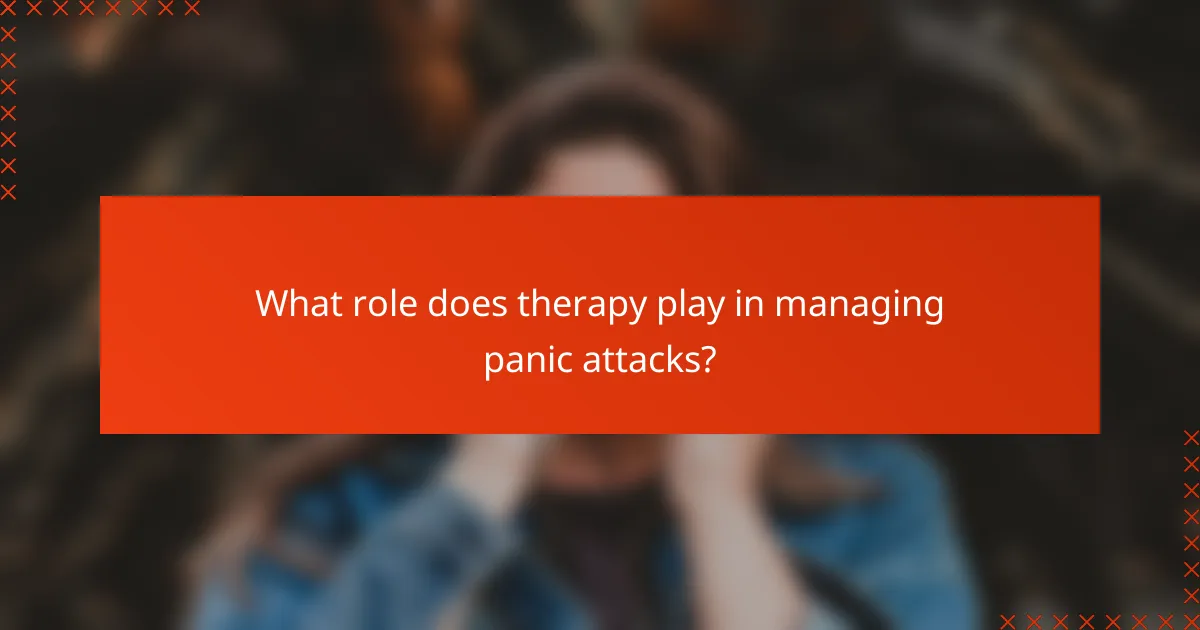
What role does therapy play in managing panic attacks?
Therapy is essential for managing panic attacks, as it provides individuals with tools to understand and cope with their symptoms. Various therapeutic approaches can help reduce the frequency and intensity of attacks, fostering emotional resilience.
Cognitive Behavioral Therapy (CBT)
Cognitive Behavioral Therapy (CBT) is one of the most effective treatments for panic attacks. It focuses on identifying and changing negative thought patterns that contribute to anxiety. Through CBT, individuals learn to challenge their fears and develop healthier coping mechanisms.
Typically, CBT involves structured sessions with a therapist, where patients practice exposure techniques to confront their fears in a controlled environment. This gradual exposure helps desensitize them to panic triggers.
Exposure Therapy
Exposure therapy is a specific type of CBT that involves facing feared situations directly. This method allows individuals to experience their panic triggers in a safe setting, reducing the fear associated with those situations over time. For example, someone who fears crowded places may gradually spend time in such environments.
During exposure therapy, patients often start with less intimidating scenarios and progressively work up to more challenging situations. This step-by-step approach helps build confidence and reduces the likelihood of panic attacks in real-life situations.
Mindfulness and Relaxation Techniques
Mindfulness and relaxation techniques are valuable tools in managing panic attacks. These practices help individuals focus on the present moment and reduce anxiety levels. Techniques such as deep breathing, meditation, and progressive muscle relaxation can be incorporated into daily routines.
Regular practice of these techniques can enhance emotional regulation and decrease the overall frequency of panic attacks. For instance, spending just a few minutes each day on mindfulness exercises can lead to significant improvements in anxiety management.
Medication as an Adjunct to Therapy
In some cases, medication may be prescribed alongside therapy to help manage panic attacks. Antidepressants and anti-anxiety medications can stabilize mood and reduce symptoms, making therapy more effective. However, medication should be viewed as a complementary approach rather than a standalone solution.
Consulting with a healthcare professional is crucial to determine the best course of action, as they can provide guidance on potential side effects and the appropriate duration of medication use. Regular follow-ups ensure that the treatment remains effective and safe.



